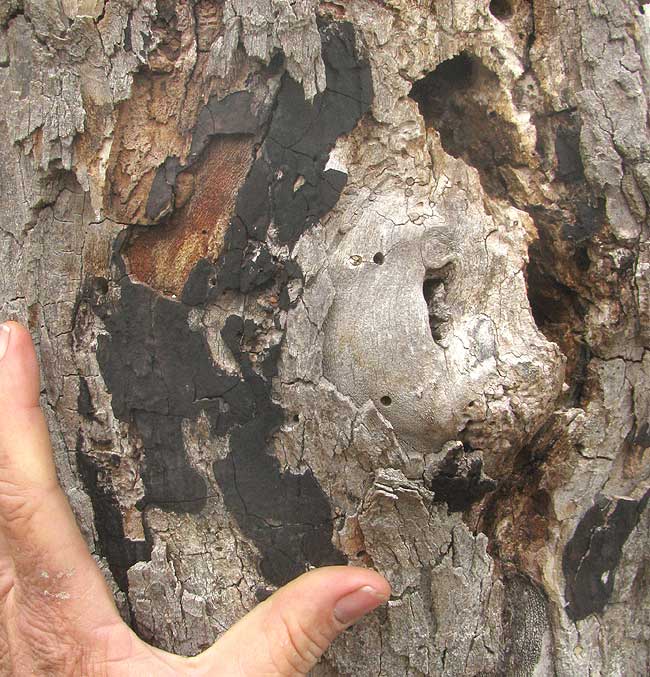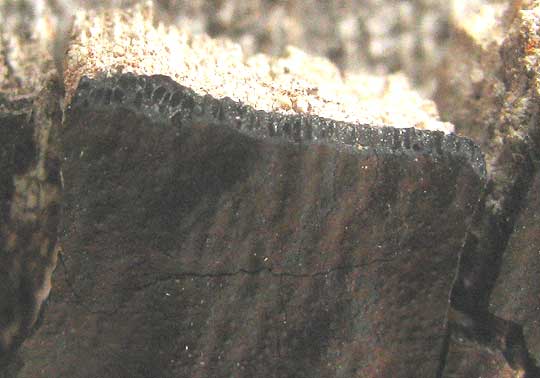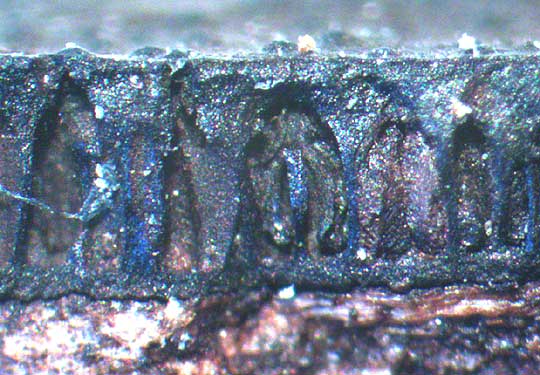Excerpts from Jim Conrad's
Naturalist Newsletter

from the March 16, 2014 Newsletter issued from the Frio Canyon Nature Education Center in the valley of the Dry Frio River in northern Uvalde County, southwestern Texas, on the southern border of the Edwards Plateau; elevation ~1750m (~5750 ft); N29.62°, W99.86°; USA
COMMON TARCRUST
A big Sycamore on the Dry Frio's floodplain died so long ago that now it's just a massive, head-high trunk standing like a detached elephant's leg along the road. One section on the disintegrating trunk was so obviously blackened by fire that at first I didn't bother looking closely at it, but after I'd passed it by, it occurred to me how curious it was that only a small part of the trunk should be burnt, with no indication of fire elsewhere, either on the trunk or neighboring trees. Going back, I looked closer at what's shown above.
Could such a hard, black, thin crust be a fungus? Breaking away a tiny piece of the crust to examine its edge with a hand lens, something interesting turned up, shown below:

Along the broken edge, tiny, oblong chambers are visible, their bottoms nearly reaching the wood the crust adheres to, and their tops nearly reaching the crust's exposed surface. These chambers reminded me of "perithecia" we've seen in certain fungi. Perithecia are hollow fruiting bodies whose interior walls bear microscopic spore-producing cells called asci. In fact, back in the Yucatan we saw the fungus called "Dead Man's Fingers" whose black, brittle surface-crust was chambered with perithecia similar to these, as you can see at https://www.backyardnature.net/yucatan/earth-tg.htm.
So, the hand lens revealed that we had a fungus, and I suspected the fungus was related to Dead Man's Fingers, though that fungus forms a fingerlike fruiting body unlike the thin, black crust covering our Sycamore's dead wood.
Back at Juniper House the dissecting scope provided a better view of the perithecia in a cross section of the crust, seen below:
 .
.
The crust's exposed surface is at the picture's top. You can see that tops of some perithecia reach the crust's surface, where they form small mounds. You can think of the mounds as tiny volcanoes from which spores are released from tubes extending from the perithecia to the crust's surface. These bumps are hard to see on such a black substrate but by overexposing a dissecting scope view of the crust's surface, they more or less became visible, as seen below:

The surface's cracks or fissures are typical of the species.
Our Dead Man's Fingers is a "sac fungus," or member of the fungal phylum Ascomycota, and further it belongs to the order Xylariales, so that's where I began looking for our black crust fungus. It didn't take long to determine that we had a fairly common species occurring throughout much of the world -- though usually it's overlooked. Often it's called Common Tarcrust. It's DIATRYPE STIGMA, the "stigma" in its binomial referring to the "spots" or bumps on the crust's surface.
Though our Common Tarcrust grew on a Sycamore, references place it on oaks, beech, birch, maple and other species. It's saprobic, meaning that it derives its nourishment from nonliving or decaying organic matter, in our case the old Sycamore trunk. The Sycamore's dead wood was so dry and crumbly that it's hard to imagine it nourishing our fungus. However, the tarcrust's action on the wood probably help make it crumbly to begin with.